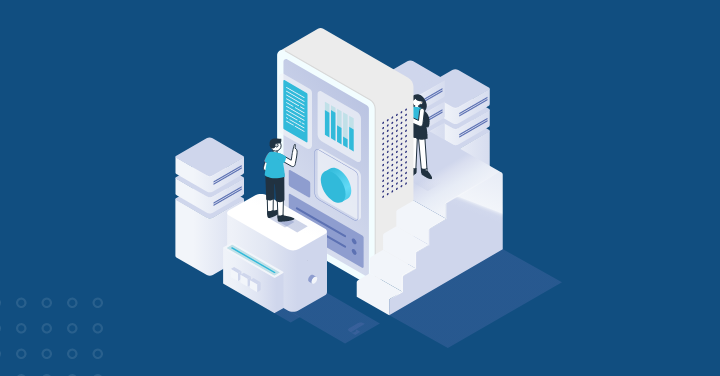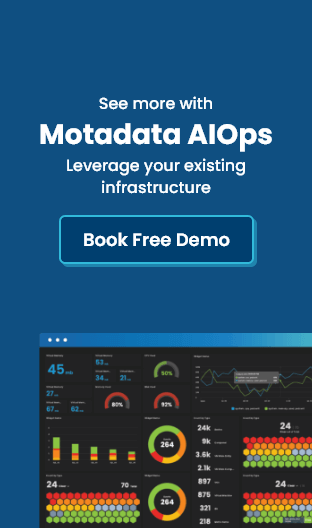Introduction: The Hybrid IT Challenge
Modern IT has become an intricate balancing act. Enterprises today rarely operate in a single environment.
Instead, their operations span on-premises data centers, private clouds, and multiple public cloud providers. This hybrid reality offers flexibility and scalability, but it also introduces new layers of complexity.
The challenge is clear: fragmented visibility, siloed data, tool sprawl, and slower root cause analysis.
Each cloud or infrastructure component might come with its own monitoring tools, creating a patchwork of partial insights.
IT teams find themselves switching between dashboards, correlating logs manually, and reacting only when issues become visible to end users.
According to Flexera’s 2024 State of the Cloud Report, 89% of enterprises now use a hybrid cloud strategy, and 80% struggle with visibility across environments.
That gap directly impacts uptime, user experience, and costs. In fact, ITIC’s 2024 Global Outage Analysis found that the average cost of a single hour of downtime now exceeds USD 300,000 for most organizations.
This is where Motadata Observability steps in. Designed to unify data across diverse environments, Motadata provides a single platform that turns fragmented telemetry into actionable insights.
With full-stack visibility and AI-driven intelligence, it helps IT teams maintain performance, resolve issues faster, and optimize hybrid environments.
The Foundation of Motadata Observability
Logs, Metrics, and Traces – The Three Pillars
Observability begins with telemetry. Logs capture discrete events, metrics record quantitative performance data over time, and traces map the journey of requests as they move through distributed systems.
Together, these three pillars provide the raw material needed to understand system health.
Motadata ingests all three data types to create a unified view. Logs of surface granular context, metrics highlight trends and thresholds, and traces connect the dots across services.
In complex, hybrid IT environments, relying on one or two pillars is insufficient. It is the correlation of all three that reveals the unknowns, issues you didn’t anticipate but can still detect and resolve.
Unified Data Ingestion
One of the most pressing hybrid IT challenges is data silos. Cloud-native apps generate telemetry in one format; legacy infrastructure in another, and third-party APIs add more noise. Motadata addresses this by providing unified data ingestion.
The platform collects logs, metrics, and traces from on-prem servers, cloud environments like AWS and Azure, containers, and microservices.
By normalizing this data into a single platform, it eliminates silos and enables IT teams to see the entire picture rather than isolated fragments.
This unified ingestion isn’t just about centralization. It’s about correlation. Motadata ties events together, so a performance dip in a database can be traced to a network bottleneck or an upstream service deployment. This holistic approach transforms raw telemetry into operational clarity.
Key Features for Hybrid IT Success
Full-Stack Visibility
Hybrid IT spans multiple layers, from physical devices and virtual machines to APIs, cloud services, and customer-facing applications.
Motadata provides full-stack visibility by correlating telemetry across all these layers into a single pane of glass.
Instead of jumping between vendor-specific dashboards, IT teams see a comprehensive view of system health, resource utilization, and performance bottlenecks.
This clarity accelerates troubleshooting and supports more informed decision-making.
Dependency Mapping and Topology
When something fails in hybrid IT, the root cause is rarely obvious. A slow application response might be tied to a misconfigured load balancer, a degraded database, or even a third-party API.
Motadata’s dependency mapping and topology features provide real-time diagrams of how systems interact.
These visualizations show how infrastructure components, services, and data flows connect. If a database slows down, IT teams can instantly see which applications depend on it, helping them prioritize remediation.
Real-time updates ensure that as systems evolve, the topology view stays accurate.
AI-Powered Anomaly Detection and Analytics (ObserveOps)
Traditional monitoring tools focus on thresholds, CPU above 80%, memory above 90%.
But hybrid environments are dynamic, and thresholds are not enough. Motadata leverages artificial intelligence to identify anomalies in real time.
By analyzing telemetry data, it detects deviations from normal behavior, even if thresholds aren’t crossed.
For instance, if API response times suddenly increase compared to established baselines, Motadata flags the anomaly before end users notice.
This AI-driven approach also reduces alert fatigue. Instead of hundreds of disconnected alerts, Motadata correlates related events and highlights what matters most. Teams spend less time triaging noise and more time resolving real issues.
Automated Root Cause Analysis (RCA)
One of the biggest drains on IT productivity is chasing symptoms instead of addressing root causes. Motadata’s automated RCA uses machine learning to trace anomalies back to their origin.
If an application slows down, Motadata might reveal that the cause was a memory leak in a container triggered by a new deployment.
By surfacing the “why” behind performance issues, it dramatically reduces Mean Time to Resolution (MTTR).
Intelligent Automation
Observability without action is incomplete. Motadata’s intelligent automation takes the next step by enabling predefined remediation.
Common issues like restarting a service, scaling cloud resources, or clearing a cache can be automated through workflows.
This self-healing capability ensures that minor problems are resolved before they escalate, freeing IT teams to focus on higher-priority initiatives.
Looking ahead, automation will evolve further with adaptive workflows that learn from past incidents.
Motadata’s roadmap positions organizations to benefit from these trends, making operations smarter and more efficient year after year.
Real-World Applications and Benefits
Use Case 1: Enhancing Healthcare IT Efficiency – Al Ahli Hospital
Al Ahli Hospital, a leading healthcare provider in the UAE, manages a complex IT ecosystem supporting critical healthcare operations.
With thousands of connected devices and systems, the hospital needed an intelligent observability solution to enhance performance, accelerate issue resolution, and ensure uninterrupted healthcare delivery.
How Motadata Helped?
- Automatically grouped related alerts to reduce noise and highlight true issues.
- AI-driven insights accelerated troubleshooting and minimized service disruptions.
- Continuous visibility into all NMS and NCM devices ensures proactive system management.
- Predictive alerts helped the IT team prevent potential failures before they impacted healthcare services.
Results & Benefits
- Intelligent automation minimized incident resolution time.
- AI-based analytics improved system reliability and performance.
- Context-aware insights enabled proactive issue handling and resource optimization.
- Freed technicians from repetitive tasks, allowing more focus on healthcare support.
Use Case 2: Telecom Resilience at Scale — MTN
MTN, one of the world’s largest telecom providers with operations across Africa and the Middle East, needed to modernize network monitoring for 285 million customers.
Traditional tools struggled to keep up with hybrid infrastructure spread across regions.
How Motadata Helped?
- Unified observability across networks, applications, and services.
- Dependency mapping made it possible to instantly correlate degraded routers with application slowdowns.
- AI-powered anomaly detection surfaced unusual latency before end users noticed.
Results & Benefits
- Faster root cause analysis across distributed networks.
- Reduced mean time to resolve critical incidents.
- Improved reliability for services relied on by millions of customers.
Use Case 3: Enabling Unified Infrastructure Monitoring for Optimized Logistics Operations- DP World
DP World, one of the largest global logistics companies, manages complex supply chain operations across multiple geographies.
For its Somalia location, the company needed a unified infrastructure monitoring platform to manage a growing IT ecosystem efficiently.
How Motadata AIOps Helped:
- Deployed to manage and monitor 150 devices in real time.
- Seamlessly processed and analyzed 5 GB/day of log data and 5 GB/day of flow data.
- Enabled anomaly detection and intelligent alerting for proactive issue resolution.
- Consolidated monitoring under a single pane of glass for end-to-end observability.
Results and Benefits:
- Centralized control and visibility across all IT infrastructure.
- Efficiently handled large-scale log and flow data volumes.
- Enhanced operational reliability with real-time tracking.
- Improved operational efficiency and reduced downtime through AI-driven automation.
- Ensured continuous infrastructure health to support mission-critical logistics operations.
Conclusion: The Path to Smarter IT Operations
Hybrid IT environments are here to stay, bringing both opportunity and complexity.
Fragmented visibility, data silos, and slow root cause analysis are barriers to operational excellence. Motadata Observability addresses these challenges head-on.
By unifying telemetry data, delivering full-stack visibility, and leveraging AI for anomaly detection and automated RCA, Motadata transforms how IT teams manage hybrid systems.
Dependency mapping clarifies relationships, while intelligent automation keeps operations running smoothly.
The result is not just better monitoring; it is smarter than IT operations. Organizations gain resilience, efficiency, and the confidence to innovate without fear of blind spots.
As the demands of hybrid IT grow, investing in observability is no longer optional. Motadata positions enterprises to stay ahead, ensuring that their IT infrastructure is not just monitored but truly understood.
FAQs:
Monitoring tracks predefined metrics and alerts on known issues. Observability, by contrast, collects and correlates logs, metrics, and traces to uncover both known and unknown problems. It allows IT teams to ask new questions and adapt to dynamic environments.
Motadata integrates with native APIs across major cloud providers, ingesting telemetry data seamlessly. This unified view helps IT teams analyze performance across clouds alongside on-prem resources.
AI powers anomaly detection, predictive analytics, and automated root cause analysis. In hybrid IT, this means early warnings, faster troubleshooting, and automated responses that maintain resilience.
Motadata collects logs, metrics, and traces across applications, infrastructure, and networks. This comprehensive dataset allows for deep analysis of system performance, dependencies, and user behavior.





